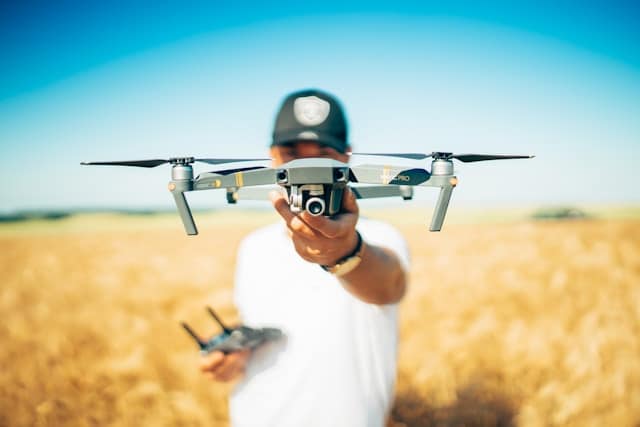The dawn of technology has brought unprecedented changes in various sectors, including agriculture. Agricultural drones using machine learning algorithms have become a crucial tool for farmers in predicting crop yields with high precision. This article delves into unraveling the potential of these smart machines in revolutionizing farming practices.
The Intersection of Agriculture and Technology
In the past, farming was a labor-intensive activity predominantly reliant on manual labor. However, the advent of technology has transformed agricultural practices, with machine learning and data-based decision-making taking center stage. One area where this transformation is evident is in crop yield prediction.
Also read : How Can AI-Driven Root Cause Analysis Tools Decrease Maintenance Costs in Manufacturing?
Accurately predicting crop yield is no easy feat. It involves analyzing numerous variables such as soil condition, weather patterns, and crop health. Traditionally, farmers would rely on their experience and intuition to make these predictions. Today, however, agricultural drones equipped with machine learning capabilities are changing the game.
These drones can collect vast amounts of data related to crop health, soil condition, and weather patterns. Machine learning algorithms then analyze this data to predict crop yields with an unprecedented level of accuracy.
In parallel : What Role Do Advanced Telematics Systems Play in Fleet Management Efficiency?
How Machine Learning Comes into Play
Machine learning is a type of Artificial Intelligence that gives computers the ability to learn from data without being explicitly programmed. In the context of agriculture, machine learning algorithms can learn from past and real-time farming data to make accurate predictions about future crop yields.
These algorithms can analyze vast datasets faster than any human can. For instance, they can analyze soil data to understand how different soil conditions affect crop yield. They can also analyze crop data to detect early signs of disease or pest infestation that could potentially affect yield.
By using machine learning algorithms, farmers can make more informed decisions about their farming practices. For example, they can decide when to plant, fertilize, or harvest their crops based on the predictions made by these algorithms.
The Role of Agricultural Drones in Data Collection
Agricultural drones have become an indispensable tool for modern-day farmers. They can cover large areas of land in a short time, collecting valuable data related to soil condition, crop health, and weather patterns.
These drones are equipped with advanced sensors that can capture high-resolution images of crops. They can detect minute changes in crop color, size, and health that may be undetectable to the human eye. This allows for early detection and management of potential threats to crop yield such as disease or pest infestation.
In addition to crop data, these drones can also collect soil data. They can analyze soil composition, moisture levels, and nutrient content. This data is invaluable in making decisions about irrigation, fertilization, and crop selection.
Predicting Crop Yields with Precision
The diverse data collected by the drones is then fed into machine learning models for analysis. These models use classification and regression algorithms to make predictions about future crop yields.
These models are trained on historical crop yield data and other relevant data such as soil condition and weather patterns. Over time, they learn to associate certain patterns in the data with specific outcomes. For instance, they might learn that certain soil conditions combined with certain weather patterns lead to high yield for a particular crop.
Once the models have been trained, they can then be used to make predictions on new data. For instance, they can predict the expected yield for a particular crop in the coming season based on current soil conditions and weather forecasts.
Through machine learning, agricultural drones can predict crop yields with a high level of precision. This helps farmers to plan their farming activities more effectively, leading to higher productivity and profitability.
The Future of Smart Farming
While the use of machine learning in agriculture is still in its early stages, the potential benefits are enormous. These technologies can help farmers to optimize their farming practices, leading to increased yields and reduced costs.
However, it’s important to note that machine learning is not a magic bullet. It’s a tool that can aid decision-making but does not replace the need for human expertise and judgment. Farmers still need to understand their land, their crops, and the local climate.
But with the help of machine learning and agricultural drones, farmers can now make more informed decisions based on data rather than intuition. And as these technologies continue to evolve, we can expect to see even more advancements in the field of smart farming.
Despite the promising future, the adoption of such technologies is still a challenge for many farmers due to the high costs involved. But as the benefits become more apparent, we can expect to see a surge in the adoption of these technologies in the near future.
The Integration of Deep Learning and Computer Vision
A key component of machine learning in agriculture lies in the realm of deep learning and computer vision. These two technologies, when used in conjunction, make it possible to analyze images captured by the drones and provide insights into crop health and yield prediction.
Deep learning, a subset of machine learning, uses artificial neural networks to mimic human brain processes. It allows the system to learn from experience, improving its performance over time. In the case of agriculture, deep learning algorithms can be trained to recognize specific patterns or anomalies in the crops using historical data, satellite imagery, or real-time drone-captured images.
On the other hand, computer vision, a field of Artificial Intelligence, enables these systems to interpret and understand the visual world. In precision agriculture, computer vision can be used to analyze crop images and detect signs of diseases, pests, or nutrient deficiencies. For instance, color changes in crops, often an early sign of a potential problem, can be detected and interpreted by computer vision systems.
Together, deep learning and computer vision create a powerful tool for real-time crop monitoring. They enable agricultural drones to not only capture high-quality images but also interpret them, providing actionable insights to farmers. This process significantly enhances the accuracy of yield prediction and allows for early intervention, thereby saving crops from potential damage.
The Impact and Challenges of Machine Learning in Agriculture
The advent of agricultural drones and machine learning has indeed revolutionized farming practices. The combination of remote sensing technology and learning algorithms has given birth to precision farming where every decision, from sowing to harvesting, is data-driven.
The ability to monitor crop health, predict yields accurately, and take appropriate action in real time is a game-changer for farmers. It allows them to plan their activities better, reduce farming risks, and maximize productivity. Machine learning models, for instance, can predict the optimum time for planting or harvesting, thus saving resources and increasing crop yields.
However, adopting these new technologies also comes with challenges. The initial investment cost for drones and machine learning systems is high. Additionally, not all farmers are tech-savvy, and training them to use these technologies effectively can be a daunting task.
Despite these challenges, the potential benefits of smart farming are too significant to ignore. A study mentioned on Google Scholar reveals that the use of machine learning and drones in agriculture can increase crop yields by up to 25%. However, to fully tap into this potential, there is a need for more comprehensive training programs, government support, and affordable solutions.
Conclusion: Towards a Future of Smart Farming
The integration of machine learning, artificial intelligence, and agricultural drones presents a promising future for agriculture. While the technology is still in its infancy with many challenges to overcome, the benefits they offer make them an indispensable part of modern farming.
The ability to accurately predict crop yields and take informed decisions can significantly boost the efficiency, productivity, and profitability of farming operations. It can also contribute to sustainable farming practices by optimizing resource usage and reducing environmental impact.
As the technology continues to advance, we can expect even more sophisticated tools for precision farming. Innovations like crop classification using machine learning, real-time disease detection, and automated farming systems are on the horizon and likely to transform agriculture in the coming years.
The potential of machine learning in agriculture is immense. It is, therefore, crucial for stakeholders to work together to address the barriers to its adoption and harness the benefits of smart farming. Whether it is making the technology more affordable, providing training to farmers, or developing robust learning algorithms, every step taken will bring us closer to a future of smart, efficient, and sustainable farming.






